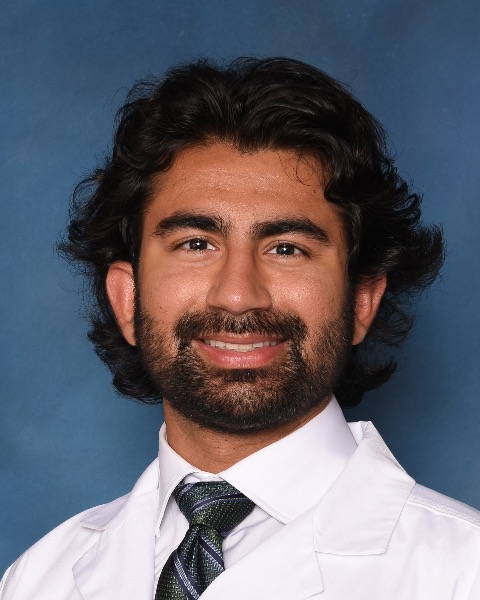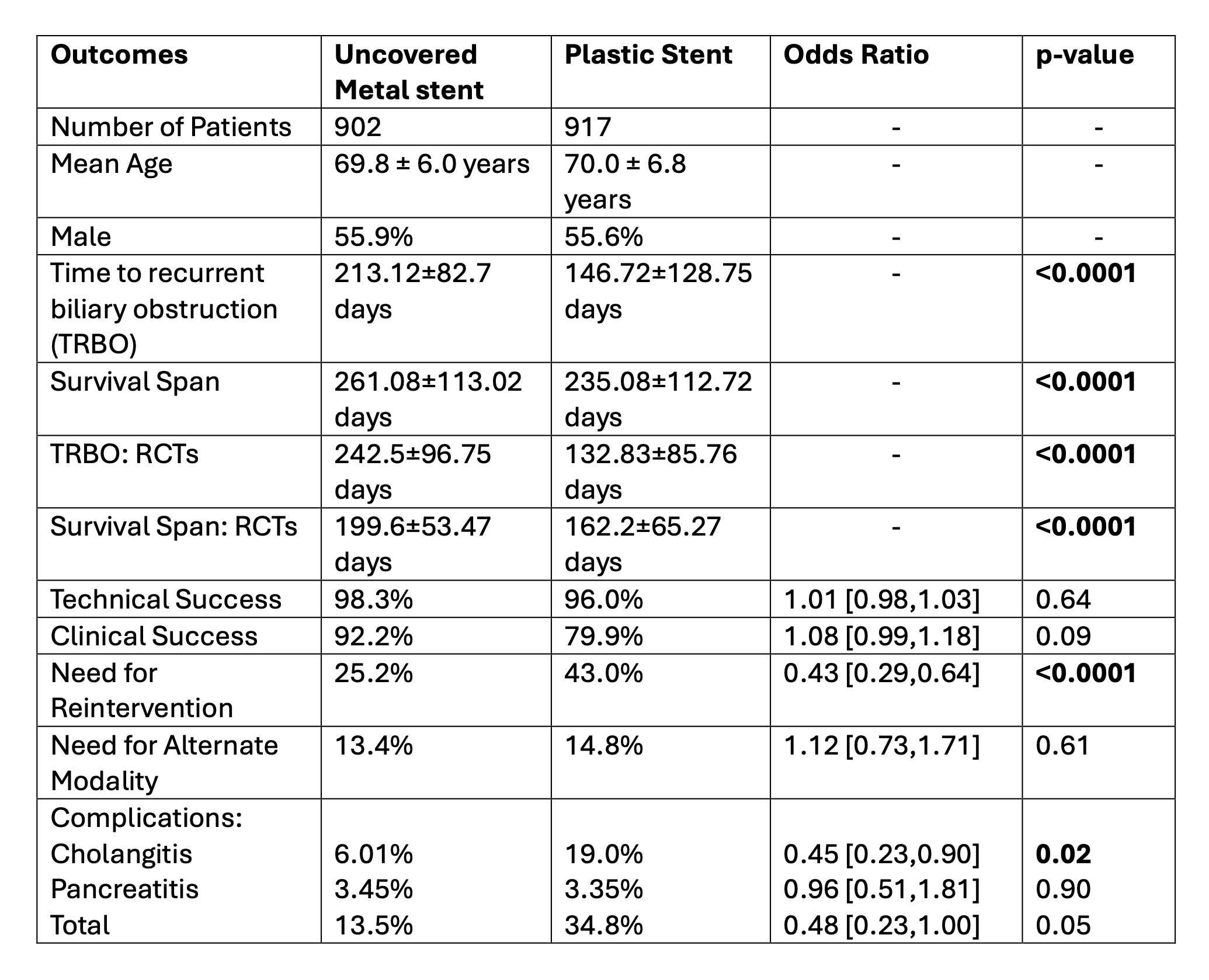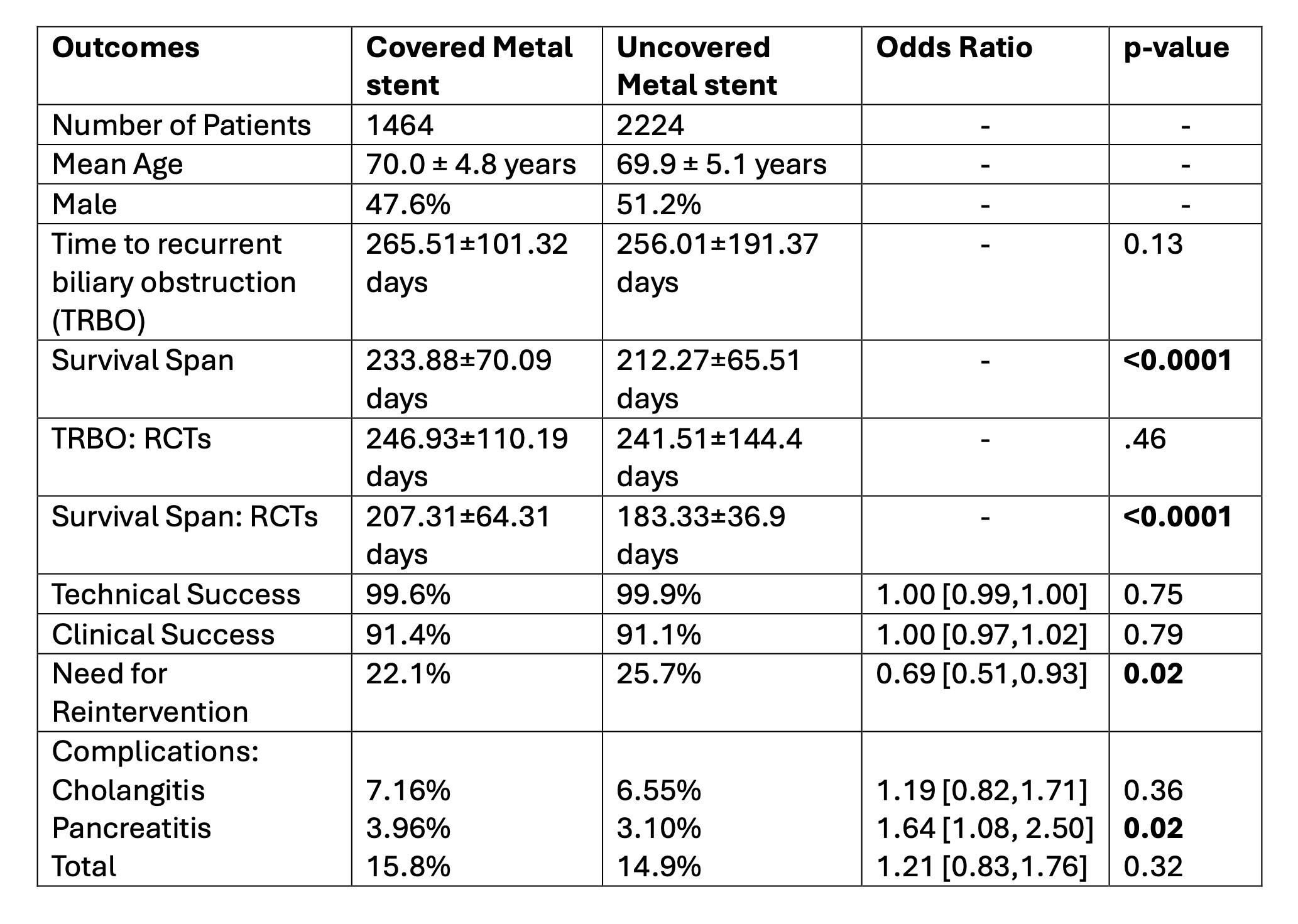Tuesday Poster Session
Category: Biliary/Pancreas
P4314 - Comparison of Safety and Efficacy of Endoscopic Biliary Stents for Malignant Biliary Strictures: A Systemic Review and Meta-Analysis
Tuesday, October 28, 2025
10:30 AM - 4:00 PM PDT
Location: Exhibit Hall

Haakim Waraich (he/him/his)
University of South Carolina School of Medicine
Columbia, SC
Presenting Author(s)
Haakim Waraich, 1, Hrithik Dakssesh Putta Nagarajan, MBBS2, Amit Hudgi, MD3, Harsh Patel, MD4, Viveksandeep Thoguluva Chandrasekar, MD2
1University of South Carolina School of Medicine, Columbia, SC; 2Medical College of Georgia at Augusta University, Augusta, GA; 3Augusta University, Augusta, GA; 4University of Kansas Medical Center, Kansas City, KS
Introduction: Malignant biliary obstruction can be hilar or distal depending on the etiology. ERCP with stent placement is indicated in most patients prior to treatment. Plastic (PS) and uncovered metal stents (UMS) are used for hilar strictures while uncovered and covered metal stents (CMS) are used for distal strictures. Clinical practice is variable, and guidelines are still unclear with heterogenous data, especially for hilar strictures.
Methods: We compared clinical efficacy and safety of biliary stents for malignant strictures. Primary outcome was time to recurrent biliary obstruction (TRBO) and secondary outcomes were technical success, clinical success, survival span (SS), need for re-intervention (NR) and complications. Pooled proportions were calculated including frequency of events over number of patients with 95% confidence limits. Random effects model by DerSimonian and Laird was used for analysis. Odds ratios (OR) were calculated by comparison of pooled proportions and p < 0.05 was considered significant.
Results: 16 studies (6 RCTs) comparing plastic (n=917) and UMS (n=902) for hilar strictures and 16 studies (10 RCTs) comparing CMS (n=1464) and UMS (n=2224) for distal strictures were analyzed. For hilar strictures, UMS had significantly longer TRBO (213.12 vs 146.72 days, p < 0.0001), significantly longer survival span (261.08 vs 235.08 days, p < 0.0001) significantly lower NR (25.2% vs 43%, OR: 0.43, p < 0.0001) and significantly lower cholangitis (19% vs 6%, p = 0.02) compared to PS. For distal strictures, comparing CMS to UMS, there was no difference in TRBO (265.51 vs 256.01 days, p = 0.13), but significantly longer SS (233.88 vs 212.27, p < 0.0001). significantly lower NR (22.1% vs 25.7%, OR: 0.69, p = 0.02) and marginally higher pancreatitis was seen (4.0% vs 3.1%, OR: 1.64, p = 0.02). Sub-group analysis for RCTs for TRBO and SS were also consistent with overall results. Other secondary outcomes were similar for hilar and distal strictures with no significant difference (Fig 1 and 2).
Discussion: This is the largest comprehensive meta-analysis to date combining malignant hilar and distal strictures (5507 patients). UMS offers longer TRBO with lower NR and a survival benefit for hilar strictures. CMS has lower NR and survival benefit with similar TRBO in distal strictures. Future studies should be designed considering stage of disease, survival span and cost of stents to guide clinicians to place appropriate stents.

Figure: Figure 1: Efficacy and safety outcomes comparing plastic and uncovered metal stents for malignant hilar biliary strictures

Figure: Figure 2: Efficacy and safety outcomes comparing covered metal stents and uncovered metal stents for malignant distal biliary strictures
Disclosures:
Haakim Waraich indicated no relevant financial relationships.
Hrithik Dakssesh Putta Nagarajan indicated no relevant financial relationships.
Amit Hudgi indicated no relevant financial relationships.
Harsh Patel indicated no relevant financial relationships.
Viveksandeep Thoguluva Chandrasekar indicated no relevant financial relationships.
Haakim Waraich, 1, Hrithik Dakssesh Putta Nagarajan, MBBS2, Amit Hudgi, MD3, Harsh Patel, MD4, Viveksandeep Thoguluva Chandrasekar, MD2. P4314 - Comparison of Safety and Efficacy of Endoscopic Biliary Stents for Malignant Biliary Strictures: A Systemic Review and Meta-Analysis, ACG 2025 Annual Scientific Meeting Abstracts. Phoenix, AZ: American College of Gastroenterology.
1University of South Carolina School of Medicine, Columbia, SC; 2Medical College of Georgia at Augusta University, Augusta, GA; 3Augusta University, Augusta, GA; 4University of Kansas Medical Center, Kansas City, KS
Introduction: Malignant biliary obstruction can be hilar or distal depending on the etiology. ERCP with stent placement is indicated in most patients prior to treatment. Plastic (PS) and uncovered metal stents (UMS) are used for hilar strictures while uncovered and covered metal stents (CMS) are used for distal strictures. Clinical practice is variable, and guidelines are still unclear with heterogenous data, especially for hilar strictures.
Methods: We compared clinical efficacy and safety of biliary stents for malignant strictures. Primary outcome was time to recurrent biliary obstruction (TRBO) and secondary outcomes were technical success, clinical success, survival span (SS), need for re-intervention (NR) and complications. Pooled proportions were calculated including frequency of events over number of patients with 95% confidence limits. Random effects model by DerSimonian and Laird was used for analysis. Odds ratios (OR) were calculated by comparison of pooled proportions and p < 0.05 was considered significant.
Results: 16 studies (6 RCTs) comparing plastic (n=917) and UMS (n=902) for hilar strictures and 16 studies (10 RCTs) comparing CMS (n=1464) and UMS (n=2224) for distal strictures were analyzed. For hilar strictures, UMS had significantly longer TRBO (213.12 vs 146.72 days, p < 0.0001), significantly longer survival span (261.08 vs 235.08 days, p < 0.0001) significantly lower NR (25.2% vs 43%, OR: 0.43, p < 0.0001) and significantly lower cholangitis (19% vs 6%, p = 0.02) compared to PS. For distal strictures, comparing CMS to UMS, there was no difference in TRBO (265.51 vs 256.01 days, p = 0.13), but significantly longer SS (233.88 vs 212.27, p < 0.0001). significantly lower NR (22.1% vs 25.7%, OR: 0.69, p = 0.02) and marginally higher pancreatitis was seen (4.0% vs 3.1%, OR: 1.64, p = 0.02). Sub-group analysis for RCTs for TRBO and SS were also consistent with overall results. Other secondary outcomes were similar for hilar and distal strictures with no significant difference (Fig 1 and 2).
Discussion: This is the largest comprehensive meta-analysis to date combining malignant hilar and distal strictures (5507 patients). UMS offers longer TRBO with lower NR and a survival benefit for hilar strictures. CMS has lower NR and survival benefit with similar TRBO in distal strictures. Future studies should be designed considering stage of disease, survival span and cost of stents to guide clinicians to place appropriate stents.

Figure: Figure 1: Efficacy and safety outcomes comparing plastic and uncovered metal stents for malignant hilar biliary strictures

Figure: Figure 2: Efficacy and safety outcomes comparing covered metal stents and uncovered metal stents for malignant distal biliary strictures
Disclosures:
Haakim Waraich indicated no relevant financial relationships.
Hrithik Dakssesh Putta Nagarajan indicated no relevant financial relationships.
Amit Hudgi indicated no relevant financial relationships.
Harsh Patel indicated no relevant financial relationships.
Viveksandeep Thoguluva Chandrasekar indicated no relevant financial relationships.
Haakim Waraich, 1, Hrithik Dakssesh Putta Nagarajan, MBBS2, Amit Hudgi, MD3, Harsh Patel, MD4, Viveksandeep Thoguluva Chandrasekar, MD2. P4314 - Comparison of Safety and Efficacy of Endoscopic Biliary Stents for Malignant Biliary Strictures: A Systemic Review and Meta-Analysis, ACG 2025 Annual Scientific Meeting Abstracts. Phoenix, AZ: American College of Gastroenterology.
